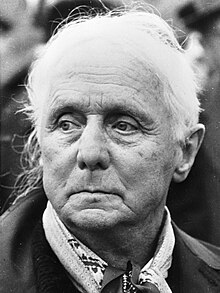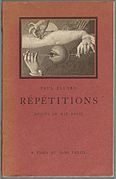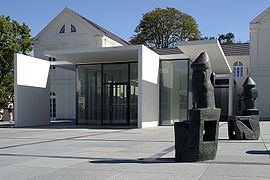Max Ernst
Max Ernst | |
|---|---|
 Max Ernst in 1968 | |
| Born | Maximilian Maria Ernst 2 April 1891 |
| Died | 1 April 1976(aged 84) Paris, France |
| Nationality | German-American-French |
| Known for | Painting, sculpture, poetry |
| Notable work | A Week of Kindness(1934) |
| Movement | Dada,Surrealism |
| Spouses | Marie-Berthe Aurenche
(m.1927–1942) |
| Signature | |
Max Ernst(2 April 1891 – 1 April 1976) was a German (naturalised American in 1948 and French in 1958) painter, sculptor, printmaker,graphic artist,and poet.[1]A prolific artist, Ernst was a primary pioneer of theDadamovement andSurrealisminEurope.[1]He had no formal artistic training, but his experimental attitude toward the making of art resulted in his invention offrottage—a technique that uses pencil rubbings of textured objects and relief surfaces to create images—andgrattage,an analogous technique in which paint is scraped across canvas to reveal the imprints of the objects placed beneath. Ernst is noted for his unconventional drawing methods as well as for creating novels and pamphlets using the method ofcollages.He served as a soldier for four years duringWorld War I,and this experience left him shocked, traumatised and critical of the modern world. During World War II he was designated an "undesirable foreigner" while living in France.
Ernst was born in Brühl. He began painting in 1909 while studying at the University of Bonn, and later joined the Die Rheinischen Expressionisten group of artists. Ernst's work often featured ironic juxtapositions of grotesque elements withCubistandExpressionistmotifs. He had a fascination with birds, often including his alter ego, Loplop, a bird, in his work. He eventually settled in France and achieved financial success in the 1950s. He died in Paris on 1 April 1976.
Early life
[edit]Max Ernst was born inBrühl,nearCologne,the third of nine children of a middle-classCatholicfamily. His father Philipp was a teacher of the deaf and an amateur painter, a devout Christian and a strict disciplinarian. He inspired in Max a penchant for defying authority, while his interest in painting and sketching in nature influenced Max to take up painting.[2]In 1909, Ernst enrolled in theUniversity of Bonnto read philosophy, art history, literature, psychology and psychiatry.[3]He visitedasylumsand became fascinated with the art work of the mentally ill patients; he also started painting that year, producing sketches in the garden of the Brühl castle, and portraits of his sister and himself. In 1911, Ernst befriendedAugust Mackeand joined hisDie Rheinischen Expressionistengroup of artists, deciding to become an artist.[3]
In 1912, he visited the Sonderbund exhibition in Cologne, where works byPablo Picassoandpost-Impressionistssuch asVincent van GoghandPaul Gauguinprofoundly influenced him. His work was exhibited that year together with that of the Das Junge Rheinland group, at Galerie Feldman in Cologne, and then in several group exhibitions in 1913.[2]In his paintings of this period, Ernst adopted an ironic style that juxtaposed grotesque elements alongsideCubistandExpressionistmotifs.[4]
In 1914, Ernst metHans Arpin Cologne. The two became friends and their relationship lasted for fifty years. After Ernst completed his studies in the summer, his life was interrupted by World War I. Ernst was drafted and served both on theWesternand theEastern Fronts.The effect of the war on Ernst was devastating; in his autobiography, he wrote of his time in the army thus: "On the first of August 1914 M[ax].E[rnst]. died. He was resurrected on the eleventh of November 1918".[5]For a brief period on the Western Front, Ernst was assigned to chart maps, which allowed him to continue painting.[2]SeveralGerman Expressionistpainters died in action during the war, among themAugust MackeandFranz Marc.
Dada and surrealism
[edit]
In 1918, Ernst was demobilised and returned to Cologne. He soon married art history studentLuise Straus,ofJewishancestry, whom he had met in 1914. In 1919, Ernst visitedPaul Kleein Munich and studied paintings byGiorgio de Chirico.The same year, inspired by de Chirico and mail-order catalogues, teaching-aide manuals and similar sources, he produced his firstcollages(notablyFiat modes,a portfolio oflithographs), a technique which would dominate his artistic pursuits. Also in 1919, Ernst, social activistJohannes Theodor Baargeldand several colleagues founded the CologneDadagroup. In 1919–20, Ernst and Baargeld published various short-lived magazines such asDer Strom,die Schammadeand organised Dada exhibitions.[2]
Ernst and Luise's sonUlrich 'Jimmy' Ernstwas born on 24 June 1920; he also became a painter.[2]Ernst's marriage to Luise was short-lived. In 1921, he metPaul Éluard,who became a lifelong friend. Éluard bought two of Ernst's paintings (CelebesandOedipus Rex) and selected six collages to illustrate his poetry collectionRépétitions.A year later the two collaborated onLes malheurs des immortelsand then withAndré Breton,whom Ernst met in 1921, on the magazineLittérature.In 1922, unable to secure the necessary papers, Ernst entered France illegally and settled into aménage à troiswith Éluard and his wifeGalain Paris suburb Saint-Brice, leaving behind his wife and son.[2]During his first two years in Paris, Ernst took various odd jobs to make a living and continued to paint. In 1923, the Éluards moved to a new home inEaubonne,near Paris, where Ernst painted numerousmurals.The same year his works were exhibited atSalon des Indépendants.[2]
Although apparently accepting the ménage à trois, Éluard eventually became more concerned about the affair. In 1924, he abruptly left, first forMonacoand then forSaigon.[6]He soon asked his wife and Max Ernst to join him; both had to sell paintings to finance the trip. Ernst went to Düsseldorf and sold a large number of his works to a long-time friend,Johanna Ey,owner of galleryDas Junge Rheinland.[2]After a brief time together in Saigon, the trio decided that Gala would remain with Paul. The Éluards returned to Eaubonne in early September, while Ernst followed them some months later, after exploring more of South-East Asia. He returned to Paris in late 1924 and soon signed a contract with Jacques Viot that allowed him to paint full-time. In 1925, Ernst established a studio at 22, rue Tourlaque.[2]
In 1925, Ernst invented a graphic art technique calledfrottage(seeSurrealist techniques), which uses pencil rubbings of objects as a source of images.[7]He also created the 'grattage' technique, in which paint is scraped across canvas to reveal the imprints of the objects placed beneath. He used this technique in his famous paintingForest and Dove(as shown at the Tate Modern). The next year he collaborated withJoan Miróon designs forSergei Diaghilev.With Miró's help, Ernst developed grattage, in which he trowelled pigment from his canvases. He also explored with the technique ofdecalcomania,which involves pressing paint between two surfaces.[note 1]Ernst was also active, along with fellow Surrealists, at theAtelier 17.[8]

Ernst developed a fascination with birds that was prevalent in his work. His alter ego in paintings, which he calledLoplop,was a bird. He suggested that this alter-ego was an extension of himself stemming from an early confusion of birds and humans.[9]He said that one night when he was young, he woke up and found that his beloved bird had died; a few minutes later, his father announced that his sister was born. Loplop often appeared in collages of other artists' work, such asLoplop presents André Breton.Ernst drew a great deal of controversy with his 1926 paintingThe Virgin Chastises the infant Jesus before Three Witnesses: André Breton, Paul Éluard, and the Painter.[10]In 1927, Ernst marriedMarie-Berthe Aurencheand it is thought his relationship with her may have inspired the erotic subject matter ofThe Kissand other works of that year.[11]Ernst appeared in the 1930 filmL'Âge d'Or,directed by theSurrealistLuis Buñuel.Ernst began to sculpt in 1934 and spent time withAlberto Giacometti.In 1938, the American heiress and artisticpatronPeggy Guggenheimacquired a number of Max Ernst's works, which she displayed in her new gallery in London. Ernst and Peggy Guggenheim were married from 1942 to 1946.
World War II and later life
[edit]
In September 1939, the outbreak ofWorld War IIcaused Ernst, being German, to be interned as an "undesirable foreigner" inCamp des Milles,nearAix-en-Provence,along with fellow Surrealist,Hans Bellmer,who had recently emigrated to Paris. He had been living with his lover and fellow Surrealist painter,Leonora Carringtonwho, not knowing whether he would return, saw no option but to sell their house to repay their debts and leave for Spain. Thanks to the intercession ofPaul Éluardand other friends, including the journalistVarian Fry,he was released a few weeks later. Soon after theGerman occupation of France,he was arrested again, this time by theGestapo,but managed to escape to America with the help of Fry andPeggy Guggenheim,a member of a wealthy American art collecting family.[12]Ernst and Peggy Guggenheim arrived in the United States in 1941 and were married at the end of the year.[13]Along with other artists and friends (Marcel DuchampandMarc Chagall) who had fled from the war and lived in New York City, Ernst helped inspire the development ofAbstract expressionism.[14][15]
His marriage to Guggenheim did not last. In October 1946 he married American Surrealist painterDorothea Tanningin a double ceremony withMan Rayand Juliet P. Browner inBeverly Hills, California.[16]The couple made their home inSedona, Arizona,from 1946 to 1953, where the high desert landscapes inspired them and recalled Ernst's earlier imagery.[17]Although Sedona was remote and populated by fewer than 400 ranchers, orchard workers, merchants and small Native American communities, their presence helped begin what would become an Americanartists' colony.Among the monumental red rocks, Ernst built a small cottage with his own hands on Brewer Road and he and Tanning hosted intellectuals and European artists such asHenri Cartier-BressonandYves Tanguy.Sedona proved an inspiration for the artists and for Ernst, who compiled his bookBeyond Paintingand completed his sculptural masterpieceCapricornwhile living in Sedona. As a result of the book and its publicity, Ernst began to achieve financial success. From the 1950s he lived mainly in France. In 1954 he was awarded the Grand Prize for painting at theVenice Biennale.[18]He died at the age of 84 on 1 April 1976 in Paris and was interred atPère Lachaise Cemetery.[12]
Legacy
[edit]Ernst's sonJimmy Ernst,a well-known German/Americanabstract expressionistpainter, who lived on the south shore ofLong Island,died in 1984.[citation needed]His memoirs,A Not-So-Still Life,were published shortly before his death.[citation needed]Max Ernst's grandson Eric and his granddaughter Amy are both artists and writers.[citation needed]
Max Ernst's life and career are examined inPeter Schamoni's 1991 documentaryMax Ernst.Dedicated to the art historianWerner Spies,it was assembled from interviews with Ernst, stills of his paintings and sculptures, and the memoirs of his wife Dorothea Tanning and son Jimmy. The 101-minute German film was released on DVD with English subtitles by Image Entertainment.
TheMax Ernst Museumopened in 2005 in his home town Brühl, Germany. It is housed in a late-classicist 1844 building integrated with a modern glass pavilion. The historic ballroom was once a popular social venue visited by Ernst in his youth. The collection spans 70 years of his career including paintings, drawings, frottages, collages, nearly the entire lithographic works, over 70 bronze sculptures. and more than 700 documents and photographs byMan Ray,Henri Cartier-Bresson,Lee Miller,and others. The core of the collection dates back to 1969 with works donated to the City of Brühl by the artist. Thirty-six paintings, gifts from the artist to his fourth wifeDorothea Tanning,are on permanent loan from the Kreissparkasse Köln. Some noteworthy works include the sculpturesThe King playing with the Queen(1944) andTeaching Staff for a School of Murderers(1967). The museum also host temporary exhibitions by other artist.[19]
TheMenil Collection,inHouston,Texas houses a significant collection of surrealist art including well over 100 pieces by Max Ernst. Notable paintings includeIn Praise of Freedom(1926),Loplop Presents Loplop(1930),Day and Night(1941–1942),Surrealism and Painting(1942),Euclid(1945),A Swarm of Bees in the Palais de Justice(1960),The Marriage of Heaven and Earth(1964). Ernst's work in the Menil Collection is typically exhibited a few pieces at a time along with other surrealist art in the collection on a rotating basis.[20]
Exhibitions, retrospectives, and honors
[edit]- Venice Biennale,Venice (1954), received Grand Prize for Painting
- Musée National d'Art ModerneParis (1959), awarded the Grand Prix national des arts
- Museum of Modern Art,New York (1961)
- Tate Gallery,London (1962)
- Kunsthaus Zürich(1963)
- Moderna Museet,Stockholm (1969)
- A retrospective of 104 works spanning the years 1920–1968, drawn entirely from theMenil Collection,toured Europe from 1970 to 1972 (Hamburger Kunsthalle,Kestnergesellschaft,Frankfurter Kunstverein,Academy of Arts, Berlin,Kunsthalle, Cologne,Musée de l'Orangerie,Musée Cantini,Maison de la Culture de Grenoble,Ancienne Douane (Strasbourg),Musée d'Arts de Nantes) and later the US (Nelson-Atkins Museum of Art,Fogg Art Museum,The Art Institute of Chicago,Solomon R. Guggenheim Museum). The opening of the exhibition in Paris was augmented with 44 pieces from various collations and opened on 2 April 1971, Max Ernst's 80th birthday.[21]
- In 2005, "Max Ernst: A Retrospective" opened at theMetropolitan Museum of Artand included works such asCelebes(1921),Ubu Imperator(1923), andFireside Angel(1937), which is one of Ernst's few definitively political pieces and is sub-titledThe Triumph of Surrealismdepicting a raging bird-like creature that symbolises the wave of fascism that enveloped Europe. The exhibition also includes Ernst's works that experiment with free association writing and the techniques offrottage,created from a rubbing from a textured surface;grattage,involving scratching at the surface of a painting; anddecalcomania,which involves altering a wet painting by pressing a second surface against it and taking it away.[22]
- Dada is Dadaretrospective group exhibition atBildmuseet,Umeå University, Sweden, running from 17 November 2017 to 20 May 2018.[23]
Documentary images
-
Opening of the Max Ernst exhibition at the gallery Au Sans Pareil, May 2, 1921. Left to right: René Hilsum,Benjamin Péret,Serge Charchoune,Philippe Soupault(top of the ladder),Jacques Rigaut(upside down),André Bretonand Simone Kahn-Breton
-
Cover ofRépétitions(1922) byPaul Éluard,with illustrations by Max Ernst
-
"Les Fusains": 22, rue Tourlaque,18th arrondissement of Pariswhere Max Ernst established a studio in 1925
-
Three bronze sculptures: left to right:Large Frog(1967),Turtle(1944), andThe Spirit of the Bastille(1961),Lenbachhaus,Munich
-
Max Ernst Museum, Brühl, Germany (photo 2004)
Selected works
[edit]Early work, Germany (1891–1922)
[edit]
|
|
First French period (1922–1940)
[edit]
|
|
American period (1941–1952)
[edit]
|
|
Second French period (1953–1976)
[edit]
|
|
Prints, collages, and illustrations
[edit]- Illustrations for books byPaul Éluard:Répétitions(1922),Les malheurs des immortels(1922),Au défaut du silence(1925)
- Histoire Naturelle(ca. 1925–1926), a set of 34 collotypes after frottages
- La femme 100 têtes(1929, graphic novel)
- Rêve d'une petite fille qui voulut entrer au carmel(1930, graphic novel)
- Une Semaine de Bonté(1934, graphic novel)
- Illustrations for editions of works byLewis Carroll:Symbolic Logic(1966, under the titleLogique sans peine),The Hunting of the Snark(1968), andLewis Carrols Wunderhorn(1970, an anthology of texts)
- Deux Oiseaux(1970, lithograph in colours)
- Aux petits agneaux(1971, lithographs)
- Paysage marin avec capucin(1972, illustrated book with essays by various authors)
- Maximiliana: the illegal practice of astronomy: hommage à Dorothea Tanning(1974, art book)
- Oiseaux en péril(1975, etchings with aquatint in colours; published posthumously)
See also
[edit]- List of German painters
- Transatlantic(portrayal in 2023 TV series)
Notes
[edit]- ^Max Ernst working in decalcomania is shown in the 1978 documentary on the Dada and Surrealist art movement,Europe After the Rain.[citation needed]
References
[edit]- ^ab"MAX ERNST".Kasmin Gallery.Retrieved13 December2021.
- ^abcdefghiSpies et al. 2005,pp. 285–286.
- ^ab"The Guggenheim Museums and Foundation".The Guggenheim Museums and Foundation.Retrieved13 December2021.
- ^Ernst et al. 1991,p. 56.
- ^Spies et al. 2005,p. xiv.
- ^Warlick 2001,p. 83.
- ^Ernst et al. 1991,p. 128.
- ^"Atelier 17: Europe and the Early Years".Swann Galleries News.10 October 2011.Retrieved20 February2020.
- ^Ernst et al. 1991,p. 285.
- ^Image:The Blessed Virgin Chastises the Infant Jesus Before Three Witnesses: A.B., P.E. and the Artist
- ^Flint, Lucy."The Kiss (Le Baiser)".Guggenheim Collection. Archived fromthe originalon 6 July 2015.
- ^abOlga's Gallery."Max Ernst biography".
- ^Iyengar, Rishi (6 April 2015)."New Google Doodle Honors Surrealist Painter Leonora Carrington".Time.Retrieved6 April2015.
- ^"Max Ernst: German Painter and Sculptor".theartstory.
- ^"Max Ernst".Ordovasart.
- ^Flint, Peter B. (21 January 1991)."Juliet Man Ray, 79, The Artist's Model And Muse, Is Dead".The New York Times.Retrieved3 December2014.
- ^Waldman 1975,p.[page needed].
- ^"Max Ernst 1891–1976".Tate Etc.
- ^Max Ernst Museum,Brühl, Germany (accessed 11 February 2021)
- ^The Menil Collection:Surrealism(accessed 11 February 2021)
- ^Hofmann, Schmied & Spies 1973,p.[page needed].
- ^"A Max Ernst Retrospective Opens Today in NY".Art+Auction.7 April 2005.Retrieved23 April2008.
- ^"DADA IS DADA".Bildmuseet.Archived fromthe originalon 24 December 2017.
- ^(15 March 2019).Max Ernst.A beautiful day,(1948).artdesigncafe.Retrieved 7 October 2019.
Works cited
[edit]- Ernst, Max; Metken, Sigrid; Schneede, Uwe M.; von Maur, Karin; Wilson, Sarah (1991). Spies, Werner (ed.).Max Ernst: A Retrospective.Prestel.ISBN978-3-7913-1140-1.
- Hofmann, Werner; Schmied, Wieland; Spies, Werner (1973).Max Ernst: Inside the Sight.University of Texas Press.ISBN978-0-914412-06-9.
- Spies, Werner; Derenthal, Ludger; Gaehtgens, Thomas; Storr, Robert; Karmel, Pepe; Heroy, Catherine (2005). Spies, Werner; Rewald, Sabine (eds.).Max Ernst: A Retrospective.New York: Metropolitan Museum of Art.ISBN978-0-300-10718-0.
- Waldman, Diane (1975).Max Ernst: A Retrospective.New York: Guggenheim Museum (NY).
- Warlick, M. E. (15 March 2001).Max Ernst and Alchemy: A Magician in Search of Myth.University of Texas Press.ISBN978-0-292-79136-7.
Further reading
[edit]- John Russell.Max Ernst: life and work(New York, H.N. Abrams, 1967)OCLC2034599
- Bodley Gallery(New York, N.Y.)Max Ernst: paintings, collages, drawings, sculpture: 30 October – 25 November 1961: Bodley Gallery, 223 East 60, New York(exhibition catalogue and commentary; published by the gallery, 1961)OCLC54157692
- Max Ernst Books and Graphic Works.Institut fur Auslandsbeziehungen, 1977.
- Legge, Elizabeth M. (1989).Max Ernst: The Psychoanalytic Sources.UMI Research Press.ISBN978-0-8357-1964-3.Max Ernst: the psychoanalytic sources
- David Hopkins.Marcel Duchamp and Max Ernst: The Bride Shared(Oxford, 1998).
- William Camfield.Max Ernst Dada and the Dawn of Surrealism(MoMA, 1993).
External links
[edit]- Max Ernstat theMuseum of Modern Art
- Max Ernst,A Retrospective,The Metropolitain Museum of Art
- Paintings in Museums and Public Art Galleries Worldwide,Artcyclopedia
- Works in the National Galleries of Scotland
- Max Ernstin American public collections, on the French Sculpture Census website
- Max Ernst
- 1891 births
- 1976 deaths
- 20th-century German male artists
- 20th-century German painters
- 20th-century German sculptors
- Artists from the Rhine Province
- Atelier 17 alumni
- Burials at Père Lachaise Cemetery
- Dada
- German Army personnel of World War I
- German collage artists
- German dadaists
- German emigrants to the United States
- German male painters
- German male sculptors
- German surrealist artists
- Guggenheim family
- German modern painters
- German modern sculptors
- People from Brühl (Rhineland)
- People from Sedona, Arizona
- People of Montmartre
- Surrealist artists
- University of Bonn alumni






